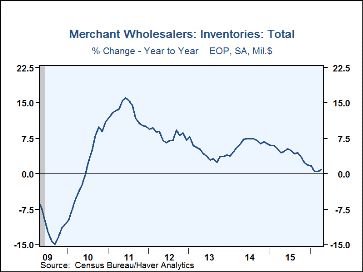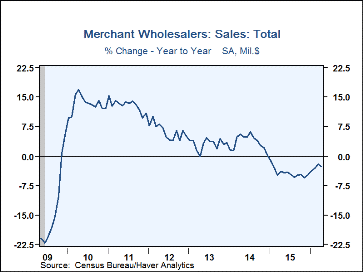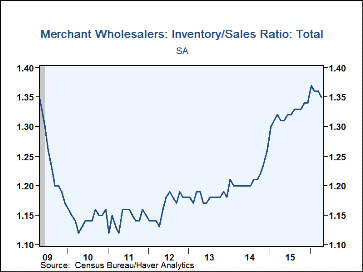 Global| Jun 09 2016
Global| Jun 09 2016U.S. Wholesale Inventories Post Firm Increase
by:Tom Moeller
|in:Economy in Brief
Summary
Inventories at the wholesale level increased 0.6% during April following a 0.2% March gain, revised from 0.1%. It was the largest increase since last June. Nondurable goods sector inventories rose 1.3% (5.5% y/y) as farm-product [...]
 Inventories at the wholesale level increased 0.6% during April following a
0.2% March gain, revised from 0.1%. It was the largest increase since last June.
Nondurable goods sector inventories rose 1.3% (5.5% y/y) as farm-product
inventories jumped 7.5% (12.1% y/y) and drug store inventories gained 2.2%
(13.0% y/y). Apparel inventories increased 1.1% (9.3% y/y) and petroleum &
products inventories rose 0.4% (-4.6 y/y). In the durable goods area,
inventories rose 0.2% (-1.9% y/y) as lumber inventories jumped 1.3% (0.7% y/y).
Electrical equipment inventories gained 0.6% (-4.4% y/y). Machinery inventories
increased 0.7% (1.4% y/y), but furniture & related product inventories fell
0.5% (+4.1% y/y).
Inventories at the wholesale level increased 0.6% during April following a
0.2% March gain, revised from 0.1%. It was the largest increase since last June.
Nondurable goods sector inventories rose 1.3% (5.5% y/y) as farm-product
inventories jumped 7.5% (12.1% y/y) and drug store inventories gained 2.2%
(13.0% y/y). Apparel inventories increased 1.1% (9.3% y/y) and petroleum &
products inventories rose 0.4% (-4.6 y/y). In the durable goods area,
inventories rose 0.2% (-1.9% y/y) as lumber inventories jumped 1.3% (0.7% y/y).
Electrical equipment inventories gained 0.6% (-4.4% y/y). Machinery inventories
increased 0.7% (1.4% y/y), but furniture & related product inventories fell
0.5% (+4.1% y/y).
Wholesale sector sales increased 1.0% (-5.3% y/y) after a 0.6% March gain. Nondurable goods buying increased 1.5% (-6.4% y/y) as petroleum & petroleum product sales jumped another 9.0% (-18.9% y/y) with higher prices. Paper product sales strengthened 1.1% (0.6% y/y) and apparel sales rose 0.3 % (-8.3% y/y). Durable goods purchases increased 0.4% (-4.1% y/y) as motor vehicle sales rose 1.6% (-4.1% y/y). Furniture & home furnishings sales improved 1.8% (1.1% y/y). Machinery purchases rose 1.5% (0.4% y/y), but electrical equipment sales declined 2.7% (-7.4% y/y).
The inventory-to-sales ratio in the wholesale sector eased to 1.35, down from the expansion high of 1.37 reached three months earlier. The nondurable ratio eased to 1.04 as the petroleum ratio fell to 0.48. The ratio in the apparel sector improved to a record 2.33, and the chemicals ratio rose to 1.26, after falling in the prior two months. In the durable goods sector, the ratio eased to 1.68, down from the August high of 1.72. The 3.01 machinery ratio was steady, but the ratio in electrical goods recovered to 1.03. The ratio of 1.81 in the auto sector was nearly the highest level of the economic expansion.
The wholesale trade figures are available in Haver's USECON database.
| Wholesale Sector - NAICS Classification (%) | Apr | Mar | Feb | Y/Y | 2015 | 2014 | 2013 |
|---|---|---|---|---|---|---|---|
| Inventories | 0.6 | 0.2 | -0.6 | 0.9 | 1.8 | 6.4 | 3.8 |
| Sales | 1.0 | 0.6 | -0.2 | -5.3 | -4.3 | 3.6 | 3.0 |
| I/S Ratio | 1.35 | 1.36 | 1.36 | 1.31 (Apr. '15) | 1.30 | 1.20 | 1.18 |
Tom Moeller
AuthorMore in Author Profile »Prior to joining Haver Analytics in 2000, Mr. Moeller worked as the Economist at Chancellor Capital Management from 1985 to 1999. There, he developed comprehensive economic forecasts and interpreted economic data for equity and fixed income portfolio managers. Also at Chancellor, Mr. Moeller worked as an equity analyst and was responsible for researching and rating companies in the economically sensitive automobile and housing industries for investment in Chancellor’s equity portfolio. Prior to joining Chancellor, Mr. Moeller was an Economist at Citibank from 1979 to 1984. He also analyzed pricing behavior in the metals industry for the Council on Wage and Price Stability in Washington, D.C. In 1999, Mr. Moeller received the award for most accurate forecast from the Forecasters' Club of New York. From 1990 to 1992 he was President of the New York Association for Business Economists. Mr. Moeller earned an M.B.A. in Finance from Fordham University, where he graduated in 1987. He holds a Bachelor of Arts in Economics from George Washington University.








